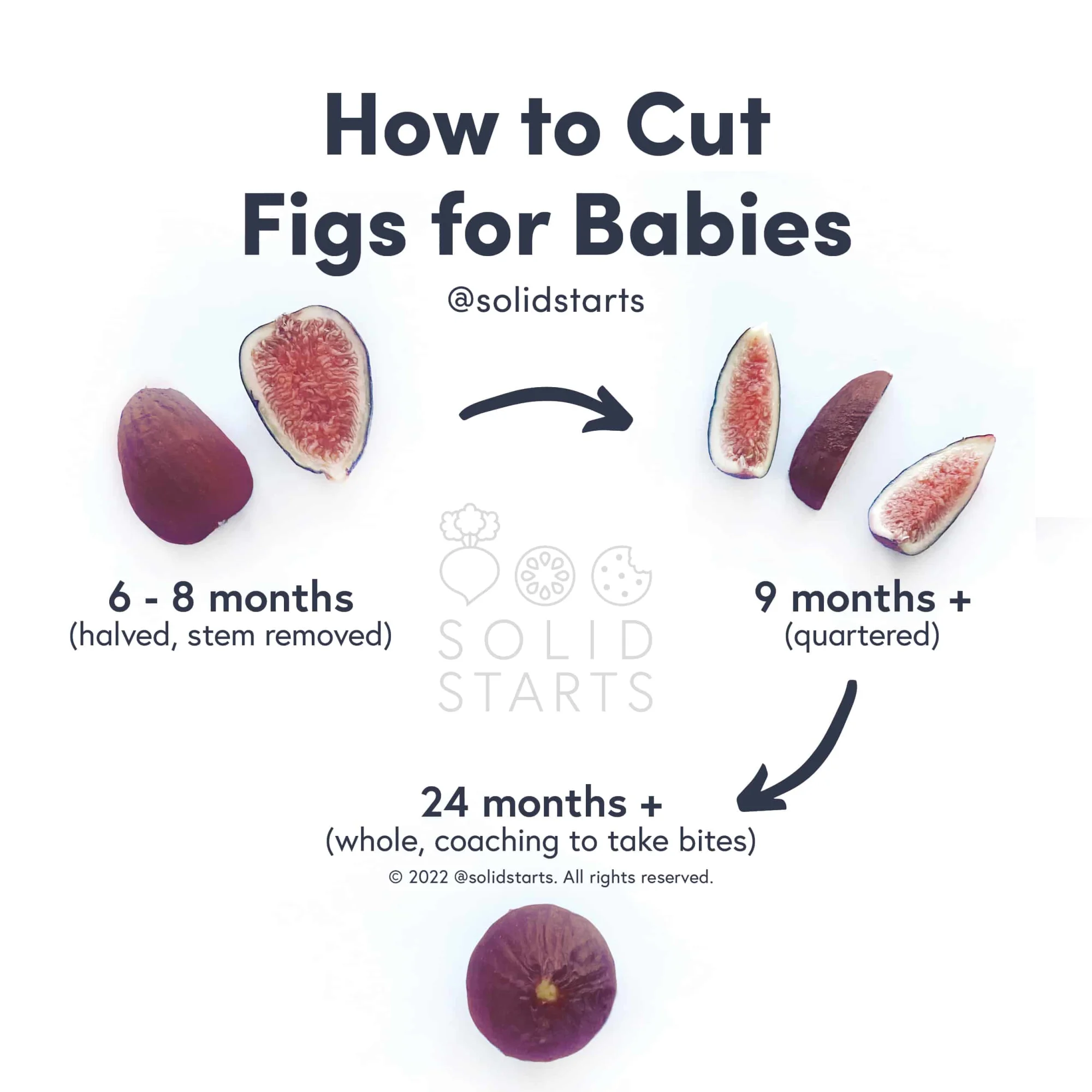Acceda a la base de datos First Foods® en Solid Starts App.
Leer másHigo
Fruta
Sugerencia de edades
6 meses
Alto contenido de hierro
No
Alérgeno común
No

When can babies have figs?
¡Lo sentimos, esta página aún no está disponible en español! Estamos trabajando tan rápido como podemos para traducir todo nuestro contenido, gracias por tu paciencia y apoyo.
Fresh figs may be introduced as soon as baby is ready to start solids, which is generally around 6 months of age.
This plump, teardrop-shaped fruit first grew wild in Southwest Asia, then spread throughout the Mediterranean and Northern Africa, where it was domesticated and began to resemble the cultivated fruits we know today. There are many fig varieties, each with variations in color of skin and flesh, from Black Mission figs with deep purple skin and crimson flesh, to the Brown Turkey figs with green skin with a purple blush and ruby flesh, to the Brunswick figs with golden flesh and dusty pink flesh.
How do you serve figs to babies?
Cada bebé se desarrolla a su propio ritmo, y las sugerencias que ofrecemos sobre cómo cortar o preparar determinados alimentos son generalizaciones para una amplia audiencia.
6 months old +:
Offer large halves of very soft, ripe figs by cutting off the stem end then slicing in half lengthwise, from stem to bottom. The fig should be soft enough that it readily mashes when gently pressed between your thumb and pointer finger. If baby bites off a big piece, stay calm and give baby a chance to independently work the food out of their mouths or chew and swallow it. Alternatively, mash fresh figs by removing the skin and mixing the inside of the fruit into soft, spreadable foods like oatmeal, ricotta cheese, or yogurt.
9 months old +:
Serve ripe, soft figs that have had the stem removed and then quartered lengthwise, or keep serving large soft fig halves for biting and tearing practice. Serve the fig pieces their own or as part of a meal, such as cooked into warm cereals. The fig should be soft enough that it readily mashes when gently pressed between your thumb and pointer finger.
18 months old +:
Continue serving soft, ripe figs cut in half, stem removed, for practice taking bites, or cut in quarters lengthwise, either as finger food or served with a utensil. At this age, if the child has mature eating skills and follows directions, you can try serving a whole, fresh fig, as long as it is ripe and soft. First, show them how to twist off the woody stem and take small bites of the fruit. Alternatively, you can teach them to pull the fruit open to inspect the inside and to take bites from there. The top of the fig (the more pointed end) tends to be easier to bite through, so once the stem has been removed, coach the child how to hold the fig's bottom part and take bites from the top. Fig skin can be challenging to chew, so expect some spitting as the child learns how to break it down with their molars. As long as the child has their molars, you can also try offering dried figs, if desired. Just make sure the child is safely seated and focused on the task of eating, as dried figs are very challenging to chew; expect some spitting throughout this process, a common response when a child isn’t confident that they can thoroughly chew a challenging texture.


¡Lo sentimos, esta página aún no está disponible en español! Estamos trabajando tan rápido como podemos para traducir todo nuestro contenido, gracias por tu paciencia y apoyo.
Videos
Are figs a choking hazard for babies?
Yes. Figs, especially when underripe or dried, can be firm and challenging to chew, qualities that increase the risk of choking. To reduce the risk, prepare and serve figs in an age-appropriate way as described in the How to Serve section. As always, make sure you create a safe eating environment and stay within an arm’s reach of baby during meals.
Learn the signs of choking and gagging and more about choking first aid in our free guides, Infant Rescue and Toddler Rescue.
Are figs a common allergen?
No. Fig allergies are uncommon, but have been reported. Individuals who are allergic to latex or who have Oral Allergy Syndrome (also called pollen food allergy syndrome) may be sensitive to fig. Oral Allergy Syndrome typically results in short-lived itching, tingling, or burning in the mouth and is unlikely to result in a dangerous reaction.
As you would when introducing any new food, start by offering a small quantity of fig for the first few servings. If there is no adverse reaction, gradually increase the quantity over future meals.
Are figs healthy for babies?
Yes. Figs offer carbohydrates, fiber, and fluid, in addition to calcium, magnesium, potassium, and vitamins B6, C, and K. Together, these nutrients help provide energy to support baby’s movement and exploration, developing gut microbiome, and hydration. They also support bone density, electrolyte balance, metabolic processes, skin health, iron absorption, immune function, and blood clotting. They also contain plenty of antioxidants that support baby’s overall health.
★Tip: Fresh figs have a short shelf-life. To maximize their freshness in the fridge, store them spaced out to avoid bruising the fruit. Only wash the fruit right before serving, since storing with residual water on the fruit can cause mildew.
Can babies have dried figs?
No. Dried fruit is firm and challenging to chew, qualities that increase the choking risk. If a recipe or dish you’d like to share with baby calls for dried figs, try rehydrating the fruit in warm water and then mincing the rehydrated fruit and stirring it into the dish.
Nuestro equipo
Escrito por
Consejos de expertos directo a tu bandeja de entrada
¡Suscríbete y recibe correos semanales con recetas, consejos y más!
Copyright © 2025 • Solid Starts Inc






